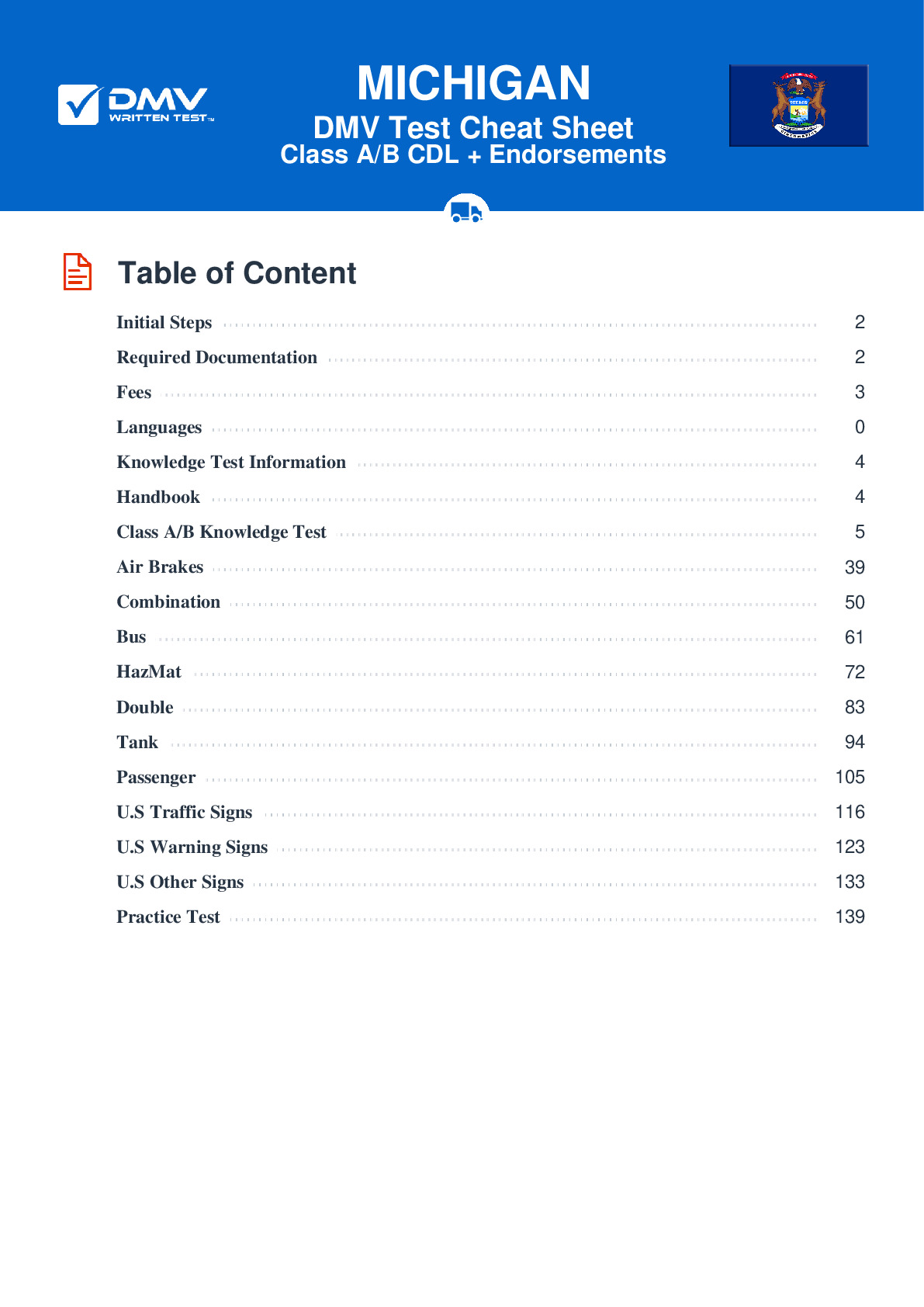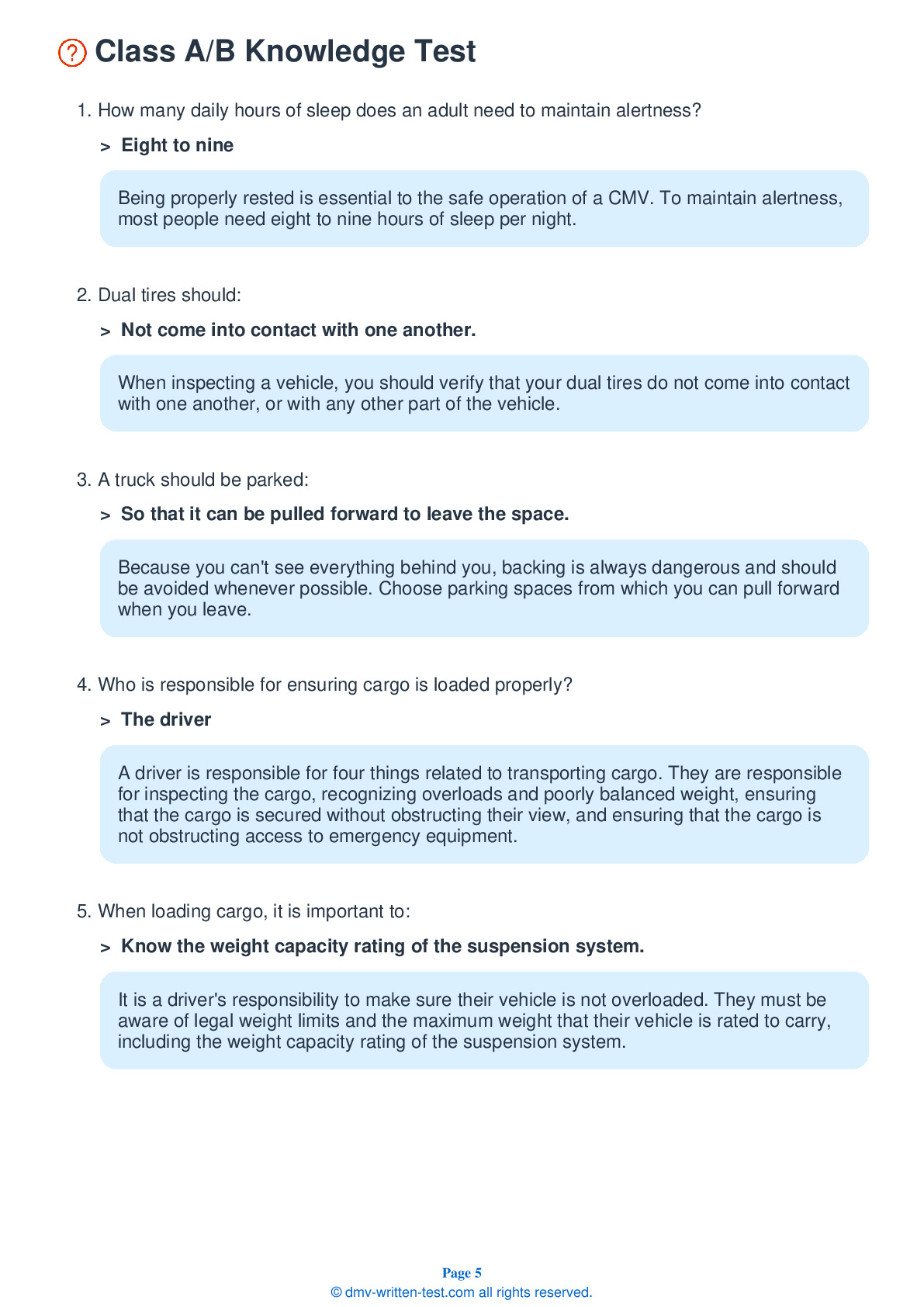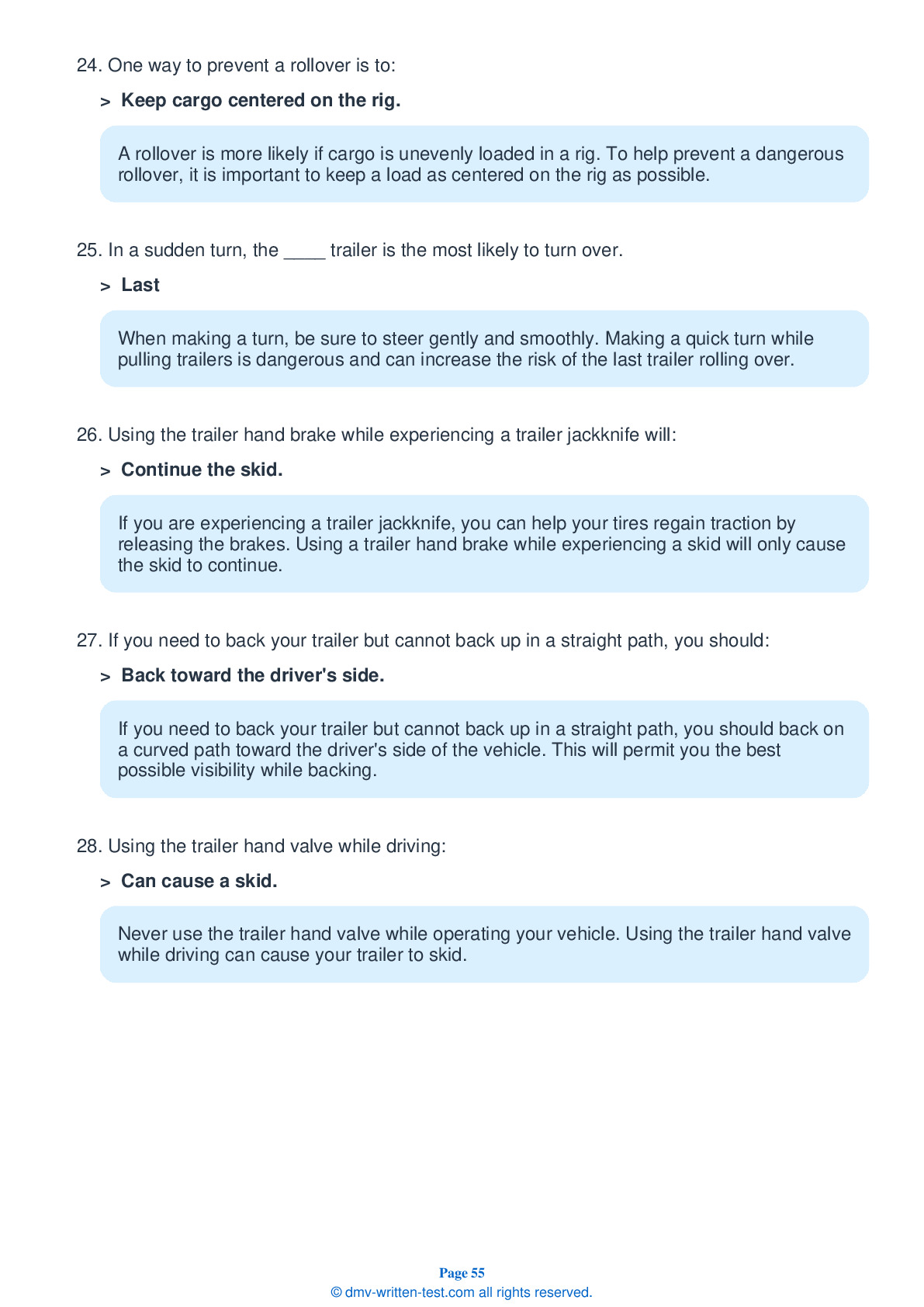Knowledge Test Class A
This license is required for driving any legal combination of vehicles, with a gross combination weight rating of 26,001 pounds or more, provided the GVWR of a trailer exceeds 10,000 pounds. To receive this license, applicants must pass a 50-question test. Test questions come from the Michigan Commercial Driver License Manual. To pass, applicants must answer 40 questions correctly. Each question has four possible answer choices. Questions come from chapters covering: Introduction, Driving Safely, Transporting Cargo Safely, Air Brakes (if applicable), Combination Vehicles, Pre-Trip Vehicle Inspection Test, Basic Vehicle Control Skills Test and On-Road Driving. Endorsements that may be used with a Class A CDL are: Hazardous materials, Tank, Passenger, Doubles/Triples, HazMat, Tank, Air Brakes and School bus.
43. When driving under wet conditions, a lack of spray coming from the tires of other vehicles indicates that:
In wet conditions, a lack of spray coming from the tires of other vehicles indicates that ice has formed on the road. Be especially cautious when traveling under wet conditions in freezing weather.
44. When transporting a load, the cargo should be inspected:
Cargo and its securing devices must be inspected before starting a trip. After beginning a trip, the driver should check the load and securing devices within the first 50 miles on the road, every three hours or 150 miles traveled, and after every break.
45. To warn drivers behind you that you will be slowing down, you should:
To let drivers behind you know that you plan to slow down, lightly tap your brake pedal a few times to flash your brake lights. It is important to communicate your intentions to other drivers.
46. For a basic vehicle control skills test, you are expected to be able to:
Maneuvers that may be included in the basic vehicle control skills test include straight line backing, offset back/right parking, offset back/left parking, driver side parallel parking, conventional parallel parking, and alley docking.
47. Which of the following is not a sign of a driver becoming tired?
Potential warning signs of fatigued driving include difficulty focusing; frequent blinking or heavy eyelids; yawning repeatedly or rubbing one's eyes; daydreaming; wandering or disconnected thinking; trouble remembering the last few miles driven; missing exits or traffic signs; having trouble keeping one's head up; drifting from one's lane; following a vehicle too closely; hitting a shoulder rumble strip; and feeling restless or irritable.
48. The rods in S-cam brakes move the slack adjusters when air pressure is added to the brake chambers. This air pressure is added to the chambers when the driver:
When pressing the brake pedal in a vehicle with S-cam brakes, air will enter the brake chambers. The added air pressure will push out the rods and move slack adjusters, twisting the brake camshafts.
49. The center of gravity in a trailer should be:
The weight of cargo in a vehicle should be distributed as low as possible. Having a center of gravity that is too high will increase the risk of a rollover.
50. If you’re unfamiliar with the area in which you must back up, you should:
Before backing up, you should get out of your vehicle and look at your line of travel. Check your clearance to the sides and overhead.
Frequently Asked Questions
To obtain a Class A CDL license in Michigan, you must first pass a written knowledge test, followed by a skills test that includes a pre-trip inspection, a basic controls test, and an on-road driving test. Additionally, you must meet certain medical and residency requirements and be at least 18 years old (21 years old for interstate driving).
Examples of combination vehicles that can be operated with a Class A CDL license in Michigan include tractor-trailers (also known as semi-trucks), tanker vehicles, livestock carriers, and flatbed trucks with attached trailers.
It's important to note that if you have a Class A CDL license, you are also authorized to operate vehicles that require Class B and C licenses. However, if you only have a Class B or C license, you are not authorized to operate vehicles that require a Class A license.
1. Age: You must be at least 18 years old to operate commercial vehicles within the state of Michigan, and 21 years old to operate commercial vehicles outside of Michigan.
2. Residency: You must be a resident of Michigan or be employed by a Michigan-based company.
3. Medical certification: You must pass a Department of Transportation (DOT) medical exam and obtain a medical certificate from a licensed medical examiner.
4. Knowledge test: You must pass a written knowledge test that covers topics such as driving safety, vehicle inspection, and hazardous materials regulations.
5. Skills test: You must pass a three-part skills test that includes a pre-trip inspection, basic vehicle controls, and an on-road driving test.
6. Background check: You must undergo a background check that includes your driving record and criminal history.
7. Payment: You must pay the required fees for obtaining a commercial driver's license in Michigan.
It's important to note that additional endorsements may be required for certain types of commercial vehicles, such as hazardous materials or passenger transport vehicles.
It's important to note that certain types of commercial vehicles may have additional age requirements. For example, drivers who transport hazardous materials must be at least 21 years old. Additionally, some employers may have their own age requirements for commercial drivers.
1. Hazmat endorsement: This endorsement is required if you plan to transport hazardous materials.
2. Tanker endorsement: If you plan to haul liquid or gas in bulk, you will need a tanker endorsement.
3. Double/triple trailer endorsement: This endorsement is required if you plan to pull double or triple trailers.
4. Passenger endorsement: If you plan to transport more than 16 passengers at a time, including the driver, you will need a passenger endorsement.
5. School bus endorsement: If you plan to drive a school bus, you will need a school bus endorsement.
6. Combination of tank and hazardous materials endorsements: This allows drivers to transport both hazardous materials and liquids or gases in bulk.
To obtain an endorsement, you must pass an additional knowledge test specific to the type of cargo or vehicle you will be transporting. Additionally, some endorsements may require additional skills tests or background checks.
1. Pre-trip inspection: You will be asked to do a thorough inspection of the vehicle before starting the engine, identifying any potential safety hazards or mechanical issues.
2. Basic vehicle control: You will be evaluated on your ability to control the vehicle in a variety of situations, including straight-line backing, turning, shifting gears smoothly, and maneuvering in tight spaces.
3. On-road driving: You must demonstrate your ability to operate the commercial vehicle safely on public roads, obeying all traffic laws while navigating through different driving conditions.
During the skills test, you will be evaluated by a certified examiner who will score you on each part of the test. In order to pass the skills test, you must obtain a passing score in each section. If you fail any part of the test, you may be required to wait a certain amount of time before attempting that portion again. It's important to note that before taking the skills test, you must pass a knowledge test and obtain any necessary endorsements for the type of commercial vehicle you plan to operate.
1. Air brakes restriction: If you did not pass the air brakes knowledge test or the skills test in a vehicle equipped with air brakes, you will have an air brakes restriction on your CDL.
2. Manual transmission restriction: If you take the skills test in a vehicle with automatic transmission, you will have a restriction on your CDL that prohibits you from operating a commercial vehicle with a manual transmission.
3. Intrastate-only restriction: If you only plan to operate commercial vehicles within Michigan, you will have an intrastate-only restriction on your CDL.
4. Medical variance restriction: If you have a medical condition that requires a medical variance, you will have a restriction on your CDL that limits your driving to the terms of your medical variance.
5. No tractor-trailer restriction: If you pass the skills test in a Class B vehicle, you will have a restriction on your CDL that prohibits you from operating Class A tractor-trailer combinations.
It's important to understand any restrictions or limitations on your CDL as they may impact your ability to work for certain employers or operate certain types of commercial vehicles.
It's important to note that while an interpreter can assist you with translation during the written test, they cannot help you with the actual test questions or provide any additional information beyond translation. If you need assistance understanding the content of the test, it may be helpful to study with materials available in your preferred language before taking the test.
If you have any questions or concerns about taking the Class A CDL written test in a language other than English, it's recommended that you contact your local Secretary of State branch office for more information.
To request accommodations, you will need to complete the Request for Accommodations (Form BDVR-153) and submit it to your local branch office of the Secretary of State. The form requires detailed information about your disability and the accommodations you are requesting.
Some examples of accommodations that may be available include extended testing time, a private testing area, a reader or scribe to assist with the test, or an alternative format for the test.
It's important to note that you will need to provide documentation of your disability from a qualified professional in order for your request to be considered. The documentation must describe how your disability impacts your ability to take the Class A CDL written test and provide recommendations for appropriate accommodations.
If you have any questions or concerns about requesting accommodations for the Class A CDL written test, it's recommended that you contact your local Secretary of State branch office for more information.
If you fail the written test three times within a two-year period, you will be required to wait six months before retaking the test. Additionally, if you fail the written test six times within a two-year period, you will be required to wait one year before retaking the test.
It's important to note that each time you take the written test, you will need to pay a fee. Therefore, it's recommended that you study and prepare thoroughly before taking the test to increase your chances of passing on the first attempt.
If you have any questions or concerns about retaking the Class A CDL written test in Michigan, it's recommended that you contact your local branch office of the Secretary of State for more information.




